Navapuliyur Pilgrimage
-Santhipriya-

Navapuliyur pilgrimage
It’s unfortunate that present generation is unaware of the importance of spiritual pilgrimages and practices which our ancestors followed several centuries ago, especially the one like Navapuliyur pilgrimage (Yathra) in south India. A few decades ago, pilgrimage to the Navapuliyur temples was undertaken to get rid of the karmic sins accrued knowingly or unknowingly in their previous births, which haunted them in their next birth in several ways. In the past, the elders beyond the age of sixty, aiming moksha (freedom from the cycle of birth and death) performed several religious rituals and engaged in other spiritual practices, one amongst them, pilgrimages such as Navapuliyur Yathra.
Centuries ago two well known Maharishis namely Vyagrapada and Pathanjali eager to witness the cosmic dance of Lord Shiva proceeded to Chithambaram; on way they worshipped Lord Shiva in various sacred temple sites pleading to the Lord to absolve them from the karmic impurities accrued across their various births so that, their pursuit to moksha (liberation) will not get hampered. It was through the pilgrimage of these two Maharishis, the significance of Navapuliyur yathra came to open and gained momentum during their period of time. Lord Shiva himself enlightened them on the significance of undertaking Navapuliyur pilgrimage after both the Maharishis witnessed the ever eternal cosmic dance of the Lord in Chidambaram.
Which are those nine Lord Shiva’s temples, the order to visit and two others of Lord Brahma and Lord Ranganathar that form the Navapuliyur pilgrimage?
- Chidambaram (Perumpatrapuliyur) – Lord Shiva
- Thirupathiripuliyur – Lord Shiva
- Erukkaththampuliyur – Lord Shiva
- Omaampuliyur – Lord Shiva
- Kaanaattampuliyur- Lord Shiva
- Sirupuliyur – Lord Shiva
- Athipuliyur – Lord Shiva
- Thappalampuliyur – Lord Shiva
- Perumpuliyur – Lord Shiva
- Tirupattur – Lord Brahma
- Srirangam – Lord Ranganathar (Lord Vishnu)
Now the real story: Both Maharishi Vyagrapada and Maharishi Patanjali travelled to the temple at Chidambaram (in Tamil Nadu, India) with a desire to witness the eternal and ecstatic dance of Lord Shiva and to seek his blessings in their pursuit of moksha. Satisfied with their sincerity and unwavering prayers, Lord Shiva allowed them to witness his cosmic dance and then instructed them to proceed to the nine specific temple sites scattered throughout the state, where he has self-manifested in the form of Shiva Linga. Worshiping him in those nine temples is essential for cleansing past sins and karmic impurities accumulated over various lifetimes. Once freed of the karmic impurities, they may proceed to Srirangam to worship Lord Ranganatha, who will grant them moksha. However, from the nineth temple where they worshipped him (Lord Shiva), they should worship Lord Brahma at the Tirupattur temple Srirangam temple, from where they should proceed to Srirangam where he (Lord Vishnu) has manifested as Lord Ranganathar. Only when all these eleven temples are visited, the pilgrimage would be deemed complete.
Lord Shiva made it clear that while he was empowered to dissolve their past karmic impurities and to guide them to the threshold of moksha, only Lord Ranganatha among the Trinity possessed the power to grant moksha in reality, provided one is absolved of all their sins and karmic impurities.
The term ‘Nava’ translates to nine in Sanskrit. Consequently, in Navapuliyur the word Nava signifies nine, while puliyur refers to the nine shrines visited by the tiger-pawed Maharishi Vyagrapada. Worshiping Lord Shiva at these nine temples is crucial for purifying oneself from past sins and the karmic impurities accumulated over multiple lifetimes. A remarkable aspect of these nine temples is the presence of one of the nine navagrahas, who were absolved of their curses in this sacred space. By residing in a separate sanctum and serving Lord Shiva, these deities help alleviate the negative effects of accumulated karmic impurities for those who worship them alongside the main deity, Lord Shiva. The nine planets, which influence an individual’s destiny—each represented in one of these temples—have been granted the authority by Lord Shiva to forgive specific karmic impurities of the devotees who offer their prayers here.
The negative effects that lead to mental disturbances in a person’s life are intricately connected to the severity of their past or present karmic sins. The nature of these consequences varies depending on the level of karmic impurities one has accumulated. While the Navagrahas play a role in determining these consequences, they also have the power to lessen or completely remove them with the grace of Lord Shiva. Those facing significant turmoil, often seek solace by visiting Navagraha temples to pray for relief, as the Brahman norm does not permit complete forgiveness of karmic sins. If all consequences were to be forgiven, individuals might lose their sense of accountability and continue to sin, merely relying on forgiveness.
The Navagrahas in temples are either found in groups or in individual temples dedicated to each one of them. Devotees visit these temples on specific days to pray to seek relief from them. Some of the Navagrahas too have been liberated from their curses by Lord Shiva in some of the temples and in gratitude, they stayed there and served the Lord there. The Navagrahas in these temples were authorised by Lord Shiva to lessen the negative effects on those who prayed them in these temples. Therefore, the Navagrahas in these temples enjoy more powers than in other their own temples. The Navapuliyur pilgrimage holds significant importance, as the Navagrahas in these nine temples can greatly mitigate the negative impacts of one’s karmic sins, and therefore, embarking on this pilgrimage not only offers relief from the detrimental effects of karmic sins but also expedites the journey toward moksha.
The learned pundits opine that it was the design of Lord Shiva to involve Maharishi Vyagrapada and Maharishi Pathanjali to undertake the Navapuliyur pilgrimage covering the nine temples, where Lord Shiva had manifested with various attributes; this pilgrimage was popular before the 12th century, but lost its credence due to the feud between Shaivites and Vaishnavites.
One day, when the cosmic serpent Adhishesha listened to her master describe the blissful realm while watching Lord Shiva’s ever eternal cosmic dance, she too felt deep desire to see it and expressed her wish to her master Lord Vishnu. Lord Mahavishnu told her ‘Adhishesha, I cannot express the vibrations I got while watching Lord Shiva’s ecstatic dance; it was so blissful that I cannot stop you from seeing it. Go and take the form of half man and half serpent in the land; people will call you Pathanjali; gain higher yogic knowledge to experience the joy of Lord Shiva’s ever eternal cosmic dance’.
Lord Vishnu continued ‘In Chidambaram, which was once known as Thillaivanam, you will find Maharishi Vyagrapada worshipping Shiva Linga inside the pathal loga beneath the dense mountains. In the in the abode of serpents, he is meditating on Lord Shiva desiring to see the ecstasy dance of Lord Shiva; go there, you too perform Pooja alongside with him and pray to Lord Shiva to see his dance. The area was named Thillaivanam because it was filled with Thillai trees, Vanam meaning forest’.
Lord Vishnu blessed the cosmic serpent Adhishesha to manifest as Pathanjali and sent him to bhoologa (earth). Cosmic Serpent Adhishesha in the form of Pathanjali, met Maharishi Vyagrapada, explained purpose of his visit and both went to Thillaivanam. Stayed there for several years, they prayed to Lord Shiva, who pleased with the sincerity of their prayers allowed them to witness his dance of ecstasy. Several years passed. When they reached the end of their life span, they undertook Navapuliyur yathra -pilgrimage to the nine shrines of Lord Shiva where he had manifested in various forms with several unique attributes; finally they were given moksha by Lord Ranganatha in Srirangam.
Maharishi Vyagrapada was the son of Maharishi Madhyanadhina,a great sage. Though Maharishi Madhyanadhina followed Shaivism, he also worshipped Lord Vishnu. One day, when Maharishi Vyagrapada asked his father’s guidance on how to free himself from karmic sins and achieve moksha (liberation from the cycle of birth and death), his father advised him get his desire fulfilled from Lord Shiva and suggested that Vyagrapada go to Thillaivanam, arduously worship Lord Shiva seeking his permission to witness the divine dance of the Lord, which only those blessed by Lord Shiva can see, and then seek his blessings to get his desire fulfilled.
Previously known as Bala Muni, meaning young sage, Maharishi Vyagrapada after meeting Maharishi Vyagrapada both of them went to Chidambaram after visiting many places along the way. Upon reaching Thillaivanam, they took bathe in the holy pond called Siva Ganga (the Ganges on Lord Shiva’s head), and resting under a tree they began to worship Lord Shiva, who was there in the form of a Shiva Ling under the same tree where they rested.
Vyagrapada used to pluck flowers climbing even tall trees in the forest and performed daily chores and pooja to the Shiva Ling. While plucking the flowers, Vyagrapada got hurt by the thorns and the rough surface of the trees. As time passed, his age restricted his energy, and came in the way of climbing the trees to pluck flowers. Feeling pity over him Lord Shiva gave the sage eyes, claws, and feet of a tiger to easily climb over the trees. Thus he came to be called Maharishi Vyagrapada, the tiger-pawed saint. Vyagra meant tiger and pada the feet.
Pleased with their prayers, compassionate Lord Shiva appeared before them and allowed them to witness the cosmic dance of Lord Shiva; both the aged Maharishis in their last leg of their life, traveled to all the nine temples of Lord Shiva in the same order as advised by Lord Shiva and worshipped him. Beginning from Chidambaram, they reached Bramhapureeswarar in Tirupattur and ended in Srirangam before taking self-Samadhi. They were given moksha by Lord Vishnu. The pilgrimage thus undertaken by them came to be called Navapuliyur pilgrimage, in which Nava meant nine and puliyur represented the temples visited by the tiger thawed Maharishi along with Adishesha.
How should one undertake the Navapuliyur pilgrimage? At Chidambaram temple, spend the whole day witnessing all three periods of pujas, next day, proceed to Thirupathipuliyur, offer prayers, next go to the temples at Erukkaththampuliyur, Omaampuliyur, Kaanaattampuliyur and then finally visit the temple at Sirupuliyur before night.
Next morning, after visiting the Athipuliyur, Thappalampuliyur and Perumpuliyur temples, the devotees must visit Tirupattur Bramhapureeswarar temple, worship Lord Brahma there and reach Srirangam to offer prayers to Lord Ranganathar, who will bestow moksha. From Srirangam, the devotees should go home without visiting any other temple.
Those undertaking the Navapuliyur pilgrimage are not permitted to visit any other temple, as it may affect the benefits of Navapuliyur pilgrimage. All the nine temples are in small villages in the outskirts of the cities that are not often visited. Since only a few devotees go to these temples, they are also open for a few hours. Therefore, the pilgrimage is to be well planned in consultation with respective temple priests who may keep the temples open for worship by the time the devotees reach there.
Navapuliyur Temples –1- Perumpatrapuliyur
 Chidambaram temple was originally known as Perumpatrapuliyur and the first to be visited in the pilgrimage of Navapuliyur Yathra. After worshiping Lord Moolattaneshwar and Goddess Sivakamasunthari, and witnessing the Arthajaama Pooja, the last pooja ritual in the night, one must attend the early morning ‘Thiruvanadhal puja’ at the sunrise before proceeding to the second Puliyur temple.
Chidambaram temple was originally known as Perumpatrapuliyur and the first to be visited in the pilgrimage of Navapuliyur Yathra. After worshiping Lord Moolattaneshwar and Goddess Sivakamasunthari, and witnessing the Arthajaama Pooja, the last pooja ritual in the night, one must attend the early morning ‘Thiruvanadhal puja’ at the sunrise before proceeding to the second Puliyur temple.
‘Chidambara Rahasya’ (Secret of Chidambaram) is one of the important rituals performed daily at Chidambaram Nataraja temple. The belief is, Lord Shiva in invisible form exists inside Citsabha, a small room, its entrance covered by a cloth screen. After performing certain rituals and at a specified time, the cloth screen will be opened and lighted camphor shown to a garland made of leaves of vilva made in gold hanging there. The philosophy is that, all pervading invisible Lord Shiva, adorned with a golden vilva garland, graciously accepts the prayers of his devotees through the illuminating light of camphor. The ritual of offering prayers to the empty space is called – Secret of Chithambaram. Lord Siva is in the dancing form in Chithambaram temple. Legend says that the Lord brought to Chithambaram three thousand Brahmins from Kashi, who were exponents in Veda shastras. The present Dikshithars of Chidambaram are reportedly in their lineage. Lord Sun serving the Lord here, removes the ill effects (Karma) to those who worship them in this temple.
This temple is reportedly 2000 years old and one of the places glorified by ‘Thevaram’. This temple is about 240 KM from Chennai. Two important festivals, – one in the Tamil month of Margazhi (Dec 16th to Jan 13th) on the auspicious star of Arudra (Arudra Darshan) and another in the Tamil month of Ani (June 16th to July 15th) on the auspicious star of ‘Uththiram’ (Ani Thirumanjanam) are celebrated annually with pomp and glory.
Lord’s name: Kanakasabapathi, Nataraja and Ponnambala Kootthan
Name of Goddess: Thiru Moolattaana Umaiyammai
Temple tree: Thillai
Address:
Arulmigu Nataraja Temple
Chidambaram
Cuddalore Dt.
Pin 608 001
Temple times:
The temple remains open from 7 AM till 12 Noon and 5 PM till 7 PM.
Navapuliyur Temples – 2- Thirupathiripuliyur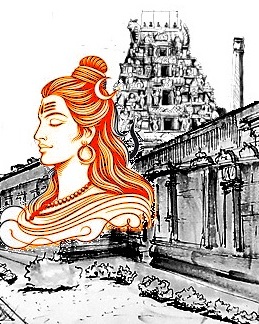
From the Perumpatrapuliyur, the next temple to be visited is in Thirupathiripuliyur. Learn about its significance.
Significant divine acts in this universe are intricately connected to Lord Shiva, with Goddess Parvathi playing prominent roles in many in them. One time, while enjoying a game in Kailash, Lord Shiva consistently emerged victorious. In an attempt to turn the tide in her favor, Goddess Parvathi playfully closed his eyes with her hands. This playful act plunged the entire universe into darkness, halting all activity. Angered by her action, Lord Shiva when cursed her to manifest on earth a frightened Goddess Parvathi sought his forgiveness.
Lord Shiva instructed her to worship him across his abodes in the universe until her left arm and left eye twitched, indicating the place where her curse would be lifted. Goddess Parvati descended to earth,and visited numerous abodes of Lord Shiva. Upon reaching the present temple site, her left eye and arm twitched. She remained in that forested area for several decades and penanced under a tree called ‘Padhiri (Stereospermum xylocarpum), which gave flowers from her body for performing her daily worship. Thus the place came to be called as Thiru (Sacred) + pathiri (Pathiri tree) + puli (Tiger bodied) + Ur (Place) = Thirupathiripuliyur. During her stay there where her curse was lifted, she was guarded by the seven celestial maidens, called Saptha Kannikas too resided there and dutifully served their mistress. Invisible Goddess Parvathi noticed several saints and sages offering prayers to Lord Shiva with hymns in the mode of music since Lord Shiva was fond of music. Thus this temple too was named as ‘Padaleeshwar’, padaleeshwar meaning the one who is attracted to music.
Lord Chandra, one of the Navagraha planets serving Lord Shiva in this temple, alleviates the ill effects caused by his planetary position when devotees pray him alongside Lord Shiva here.
This temple site falls under the district of Cuddalore, 44 miles from Chidambaram. It is 1/2 km from Thirupathiripuliyur railway station and 1/2 km from Cuddalore bus stand.
Lord’s name: Thondra Thunai Nathar.
Goddess: Periyanayagi ammai, Kothainayagi
Temple tree: Padhiri
Sacred tank: Brahma Theertham
Temple times:
The temple remains open from 7 AM till 12 Noon and 5 PM till 9 PM. Since the temple is in remote village, not visited by many, the temple timing is not adhered to and therefore it is advisable to contact the priests (94433 04978 or 098949 27573 or 04142 236728) in advance before visiting there.
Navapuliyur temples – 3 – Erukkaththampuliyur
 From Thirupathiripuliyur, the next temple to be visited is Erukkaththampuliyur. Learn about its significance.
From Thirupathiripuliyur, the next temple to be visited is Erukkaththampuliyur. Learn about its significance.
Erukkaththampuliyur is 73 km from Thirupathipuliyur and 13 km from Virudrachalam town. Since the name of the village Erukkaththampuliyur is not widely known, it is generally called as Rajendrapattinam.
One of the devotees of Lord Shiva, Neelakanta Banar came from a musical family. Together with his wife, he used to visit various temples dedicated to Lord Shiva to play hymns on Lord Shiva through a string instrument known as the Yaazh (a string instrument like Veena) .
In those period, the Banar tribe faced restrictions that kept them from entering the temples because of caste discrimination. As a result, they worshipped Lord Shiva from outside the temple grounds. One day, standing outside temple precincts, Neelakanta Banar played hymns on his instrument praising the Lord. Touched by the beautiful melodies, Lord Shiva appeared in the dreams of many of his devotees and instructed them to create a separate entrance for Neelakanta Banar and his wife to enter the temple worship and play music on him. He also shared the same message in the dream of Neelakanta Banar.
As directed by the Lord in their dreams, the devotees created a special passage and allowed the couple to enter the temple to offer worship to the Lord in the sanctum. Unmindful of the damp floor, when the couple settled down and played music in praise of the Lord, touched by the enchanting melody, Lord Shiva again instructed the devotees to set up a plank for them to sit and continue to play the music. The crowd was thrilled by the gesture of the Lord and arranged a wooden plank for them to sit.
During the wedding of Thirugnana Sambandhar, when the life span of both the Banars ended, both of them merged into the feet of Lord Shiva, when a frightening light appeared. The day is celebrated in the month of Vaikasi (May-June) on the day of Star Moola. In this temple site, Lord Shiva has granted salvation to many and has also blessed childless King Rajaraja Chola to get an offspring. Lord Muruga too was relieved of his curse and got back his speech which was lost earlier.
Lord Kethu, one of the Navagraha planets serving Lord Shiva in this temple, alleviates the hardships caused by his planetary position when devotees pray him alongside Lord Shiva here.
Lord’s name: Neelakanteswar
Goddess name: Neelamalarkanni
Temple tree: Erukku
Temple times:
The temple remains open from 7 AM till 12 Noon and 5 PM till 7 PM. Since the temple is in remote village, not visited by many, the temple timing is not adhered to and therefore it is advisable to contact the priest Ganesa Gurukkal ( Tele No 9487703524 ) in advance before visiting there.
Navapuliyur temple – 4 – Omaampuliyur
From Erukkaththampuliyur, the next temple to be visited is Omaampuliyur. Learn about its significance.
This temple site is 30 KM away from Chidambaram and 18 KM away from Kutralam which is in Mayiladuthurai-Kumbakonam route. One has to travel through Kaattumannar kovil to reach Omaampuliyur which is in a small village on way. The distance between Omaampuliyur and the next temple site called Kaanaattampuliyur is hardly four kilometers .
This temple has an interesting legend. Once Lord Shiva while explaining the meaning and the power of the primordial sound (pranava mantra) OM, to his consort Goddess Parvathi, though she listened to him attentively, the wordily attachments distracted her attention for a fraction of a moment.
Upset by her distraction, when Lord Shiva cursed her to take birth on earth, frightened Goddess Parvathi sought his forgiveness. Lord Shiva told her to take birth on earth, continue worship him in the temples in the universe and at the right time, he would appear before her to lift the curse and teach her about the Pranav mantra OM once more.
Acting at the advice of the Lord, Goddess Parvathi took birth earth and meditated at the current temple site for a long period of time. Pleased with her devotion, Lord Shiva appeared as Guru Dakshinamurthi and taught her on the power of the pranava mantra OM. As a result, Goddess Parvathi gained complete knowledge of OM. To mark this divine event, Lord Shiva took the name Pranava Vyagrapureeswarar in this temple. Since the inner meaning of the mantra OM was fully revealed to Goddess Parvathi here, the place came to be known as Omaampuliyur.
Significant feature in this temple is the importance given to Lord Guru Dakshinamurthi who has been kept in a sanctum in between the sanctums of both Lord Shiva and Goddess Parvathi. Even though Lord Shiva and the Lord Guru Dakshinamurthi are one and the same, Lord Shiva appears in both the forms to bless the devotees who worship both of them separately.
Lord Guru one of the Navagraha planets serving Lord Shiva in this temple, relieve the sufferings caused by his planetary position when devotees pray him alongside Lord Shiva here. Devotees also pray here to Lord Dakshinamurthi to gain knowledge and good education for their children.
Lord’s Name: Pranava Pureesvarar and Thuyar theertha Nathar
Goddess Name: Pushpalathambigai and Poongodi Nayagi
Temple Tree: Ilandhai (Name in english: ziziphus jujuba)
Sacred water: Kollidam, Gowri Theertham
Temple address:
Sri Pranava Vyagyapureeswarar temple,
Omaampuliyur
Cuddalore Dt.
Pin: 608 306
Temple times:
The temple remains open from 7 AM till 12 Noon and 5 PM till 9 PM. Since the temple is in remote village, not visited by many, the temple timing is not adhered to and therefore it is advisable to contact the priest (Jagatheesa Gurukkal 04144-264845) in advance before visiting there.
Navapuliyur temples – 5- Kaanaattampuliyur

From Omaampuliyur the next temple to be visited is Kaanaattampuliyur. Learn about its significance.
Two stories highlight the significance of this temple. First, the sages from the Dandakaranya forests came here to offer prayers to Lord Shiva. Upon their arrival, they discovered that every grain of sand seemed to resemble a ‘Shiva Linga,’ making it difficult to find the real one and walk comfortably. So, the sages offered their prostrations from afar and left. Since then, it has become customary for devotees visiting this temple to take some of the sacred sand, as they believe it will bring them good fortune.
The second story involves the cosmic serpent Adhishesha, the divine bed of Lord Vishnu. After transforming into Maharishi Pathanjali and experiencing the blissful dance of Lord Shiva in Chidambaram, he came to this temple and witnessed the Lord’s dance here as well. When Lord Shiva asked if the Maharishi’s desire got fulfilled, he expressed his wish to see the dance of the Lord every day. Pleased with this devotion, Lord Shiva allowed him to remain here for a long time and, in honor of him, enshrined himself at this temple site under the name of Pathanjaleeswarar.
During the months of April and May, the sun rays fall directly on the ‘Shiva Linga’ for three days in each of the month. This is interpreted as Lord Sun coming down to offer respects to Lord Shiva. The temple has two interesting features. Lord Murugan’s consort Goddess Valli is depicted with a long ear ring (Called Pambadam in the villages) typically worn by elderly women folks and secondly, Lord Dakshinamurthi is seen without Kallala tree hanging over his head.
Lord Raghu one of the Navagraha planets serving Lord Shiva in this temple, relieve the sufferings caused by his planetary position when devotees pray him alongside Lord Shiva here.
The distance between Omaampuliyur and Kaanaattampuliyur is hardly four kilometers
Lord’s Name: Pathanjaleeswarar or Pathanjali Nathar or Somaskanthar
Goddess Name: Kolvalayambigai
Temple Tree: Vellaierukku (Calotropis gigantea)
Sacred Water: Soorya Pushkarani
Address:
Arulmigu Pathanjaleeswar temple
Kaanaattampuliyur
Muttam Post
Kattaumannaarkudi Taluk
Cuddalore District
Pin: 608 306
The temple remains open from 7 AM till 12 Noon and 5 PM till 9 PM. Since the temple is in remote village, not visited by many, the temple timing is not adhered to and therefore it is advisable to contact the priest Jayachandran Gurukkal (9790333377, 9894684269) in advance before visiting there.
Navapuliyur temples – 6- Sirupuliyur
From Kaanaattampuliyur the next temple to be visited is Sirupuliyur. Learn about its significance.
Although conflicting legends are associated with this temple, only stories on Maharishi Vyagrapada and Maharishi Pathanjali are relevant. After enjoying Lord Shiva’s celestial dance at Chidambaram, Maharishi Vyagrapada and Maharishi Pathanjali visited numerous other temples of Lord Shiva. With each passing days, when aging reduced their mobility, they prayed to Lord Shiva to liberate them granting Moksha. Lord advised them to first complete the visit to all the nine temples where he has manifested, then go to Tirupattur, worship Lord Brahma and finally go to Srirangam and worship Lord Ranganathar, incarnate of Lord Vishnu to get liberated.
Due to aging when their eyesight too partially impaired, they lost their way to Srirangam and took a wrong route unknowingly. It was late night and unable to proceed further, they prayed to Lord Vishnu for help. Compassionate Lord Shiva came down in the form of a human and guided them take the correct route. Further he got himself enshrined in a small shrine in the name of ‘Vazhithunai Nathar’ meaning guide in travel at the spot where he appeared and guided them.
By then Lord Ranganathar also came down in search of them. Realizing that the elderly Maharishis wouldn’t be able to see him in his original grand form, he transformed himself into a small boy to appear before them and later enshrined himself in a nearby small shrine close to Lord Shiva’s temple. Since Lord Shiva helped the Maharishis to get the vision of Lord Vishnu, indirectly implying that both he and Lord Vishnu are one and same, Sirupuliyur gains significance in this tour. Those who undertake tour of Navapuliyur pilgrimage must visit both these temples.
Sirupuliyur is situated 20 KM from Mayavaram in the village called ‘Naadaakkudi’. Lord Mercury (Lord Bhutan), one of the Navagrahas planets relieve the sufferings of those who pray him here along with Lord Shiva.
Lord’s Name: Vazhithunai Nathar and Marga Bantheeswarar
Name of Goddess:
Temple times:
The temple remains open from 7 AM till 12 Noon and 5 PM till 9 PM. Since the temple is in remote village, not visited by many, the temple timing is not adhered to and therefore it is advisable to contact the priest (Shankar Gurukkal :9791514671) in advance before visiting there.
Navapuliyur temples: No-7- Athipuliyur
 From Sirupuliyur the next temple to be visited is Athipuliyur. Learn about its significance.
From Sirupuliyur the next temple to be visited is Athipuliyur. Learn about its significance.
It is located 17 Kilometers west of Nagapattinam in the Nagapattinam – Thiruvarur highway. This temple can be seen on the northern bank of river Kadugai.
The history of this temple is not known except that this is one in the Navapuliyur temples. The image of Lord Kalyana Sundareswarar is carved in a rock behind the Shiva Ling in the sanctum. It is believed to have been sculpted (referred to as Shila Sthapana) by the great Sage Agastya using his divine powers. After crafting the image, he lingered there for several days, worshipping Lord Shiva in the form of a married couple.
Legend has it that Sage Agastya, eager to witness Lord Shiva’s wedding, journeyed through south to the Himalayas and on the way, he rested at this temple site and worshipped the Lord expressing his heartfelt desire. Moved by his devotion, Lord Shiva, along with his consort, appeared before him as a married couple. Even Maharishi Vyagrapada and Maharishi Pathanjali reportedly witnessed this divine occasion. Devotees flock to this temple on the three Pradosha days and worship Lord Kalyana Sundareswarar in hopes of success with their marriage proposals. Five water tanks are seen around the temple and it’s widely believed that bathing in all five and performing the srartha ceremony (an annual ritual for the deceased) here, absolves the sins of one incurred from failure to perform the srartha ceremony for the departed ancestors.
This temple too has an interesting feature in the sanctorum where Lord Shiva (Shiva Ling) faces south while Goddess Parvathi is facing West, which is the opposite of what is seen in most other temples.
Name of Lord: Chithambareswar
Name of Goddess: Sivakamasunthari
Name of Theertham (water tanks):-
Temple Address:
Shri Chithambareswar temple
Kilvilur or Kivalur Block
Nagapattinam district
Pin :- 611 104
Temple times:
The temple remains open from 7 AM till 12 Noon and 5 PM till 9 PM. Since the temple is in remote village, not visited by many, the temple timing is not adhered to and therefore it is advisable to contact the priest (Visvanatha Gurukkal 9751195622 or 9943596849) in advance before visiting there.
Navapuliyur temples: No-8:- Thappalampuliyur
From Athipuliyur shrine the next temple to be visited is Thappalampuliyur. Learn about its significance.
This shrine is located five kilometers from Thiruvarur in the Nagapattinam district. According to the temple’s history, it’s a 1000-year-old place of worship where devotees have revered the self-manifested Lord Shiva for countless ages. Scholars believe that in Kretha Yuga this temple site was referred as Tarparavanam, in Thretha Yuga it was Madhu Vanam, in Dwapara Yuga it was Deva Vanam and in Kali Yuga it is called as Vyagrapuram.
Alongside Maharishi Vyagrapada, another well known Maharishi Manduga, also worshiped Lord Shiva at this temple. The term ‘Manduk’ translates to frog, which is referred to as ‘thappalai’ in tamil. Maharishi Vyagrapada possessed a tiger’s leg, known in Tamil as Pulikal. Since both Maharishies spent considerable time worshipping the Lord, the temple earned the name Thappalaa + Puliyur i.e Thappalampuliyur in honor of both the Maharishis. This naming has led to some confusion, making it seem like a frog and a tiger together worshiped Lord Shiva here.
There’s a fascinating story about Goddess Parvathi, named as Nithya Kalyani in this temple, which implies that she marries the Lord everyday (nithya meant daily and Kalyani for the one who gets married). A sage once worshipped an unknown Goddess in the form of a child and named her Kalyani. One day he discovered that Kalyani was missing. Heartbroken, when he pleaded with Lord Shiva to help him find her, the Lord appeared before him with his consort in the form of Child Kalyani to reveal that the child was indeed Goddess Parvathi, and that he had married her here. Subsequently, the inspired sage dedicated many years to the worship of the child Goddess Nithya Kalyani through upasana, ultimately reaching a state of self-samadhi. Upasana involves meditating on a chosen deity, fostering a deep mental and emotional connection with the divine.
When several marriage proposals fail, they visit this temple and pray to Goddess Parvathi for success. Similarly when couples fail to get offspring, they come here and offer prayers for an offspring. Once the greatest amongst the sages, Kanchi Paramacharya visited this temple and commented that the Goddess enshrined here was Bogamokshapradayini, meaning the one who grants both worldly pleasures- (Bhoga) and spiritual liberation (Moksha) as pradayini (Giver).
In a separate sanctum, Lord Saniswarar is placed facing east, adjacent to the sanctorum of Lord Shiva. Lord Saniswarar faces east only in the temples of Tirunallaaru, Thirukollikkaaval and Thirukollikkaadu. Offering his services to Lord Shiva in this temple, Lord Saniswarar seated in a separate sanctum removes the malefic effects on those who worship him alongside Lord Shiva in this temple.
Separate sanctorums for Lord Ekapatha Rudrar and three legged Lord Jwareshwarar is also seen. By worshiping three legged Lord Jwareshwarar, ailments like knee and joints pain gets cured. The idols of Lord Shiva in dancing form- Nataraja- surrounded by several Rishis, Sages and Celestial (Goshta Devathas or group of deities ) is sculpted on the rock wall of the temple.
It is generally believed that if someone goes to the temple for seven weeks and offer seven whole sticks (unbroken) or balls of turmeric to Goddess Nithya Kalyani, and takes it home to make a paste to apply over body or mix the powder with water and drink, their honest prayers will be heard. Likewise, those living outside the town when offer 21 whole sticks (unbroken) or balls of turmeric to the Goddess and follow the same steps, their sincere prayers will also be answered. This practice is based on beliefs that have been passed down for many years.
Name of Lord: Vyagrapureeswarar
Name of Goddess: Nithya Kalyani
Sacred Tank: Vyagrapada and Pathanjali Theertham
Temple Tree: – Kaattaathi and Vanni
Temple Address:
Shri Thappalampuliyur temple
Thiruvarur
Nagapattinam district
Pin: – 611 106
The temple remains open from 7 AM till 12 Noon and 5 PM till 9 PM. Since the temple is in remote village, not visited by many, the temple timing is not adhered to and therefore it is advisable to contact the priest in advance before visiting there. Name of the priest and contact No: – 9840036514 (T.P. Venkataraman) or 9942984901(Kalyanaraman) or 9786582271 (Swaminatha Gurukkal)
Navapuliyur temples: No-9:- Perumpuliyur
 The last leg in the Navapuliyur pilgrimage is visit to Perumpuliyur temple which is situated in a place called Thiruneithaanam in the Thiruvaiyaru to Kallanai route.
The last leg in the Navapuliyur pilgrimage is visit to Perumpuliyur temple which is situated in a place called Thiruneithaanam in the Thiruvaiyaru to Kallanai route.
Estranged couples, those in disputes and families with conflicts often visit this temple to worship Lord Shiva and Goddess Uma(Parvathi). The belief has been that their disagreements get resolved like a miracle, allowing them to reunite. Devotees also say that even divorce cases in litigation can have positive outcomes when families pray here. In summary, this temple is well-known for reuniting the estranged couples clearing their misunderstandings. People seeking a peaceful family life come to the temple to pray, and they believe they will be blessed.
The unique feature in this temple is that unlike other temples where the Navagrahas are enshrined facing different directions, here all the Navagrahas are enshrined facing Lord Sun.
Lord Mars, one of the Navagraha planets here the removes the ill effects occurring on account of Karmas of those, who pray him here along with Lord Shiva.
Name of Lord: Vyagrapureeswarar
Name of Goddess: Soundaryanayaki
Temple Address:
Shri Vyagrapureeswarar Tiru kovil
Perumpuliyur
Thillasthaanam post
Via Thiruvaiyaru, Tanjavur district
Pin: – 613 203
The temple remains open from 7 AM till 12 Noon and 5 PM till 9 PM. Even though the temple timings are mentioned in the temples, the temple timings are not strictly followed by the priests as the temples are situated in remote villages. Therefore it is advisable to contact the priest Suresh Gurukkal (9443447826) beforehand to confirm the time of visiting the temples.
Conclusion
Once devotees complete their worship in Perumpuliyur, they have to proceed to Bramhapureeswarar temple in Tirupattur to offer prayers to Lord Brahma and also to Maharishi Pathanjali’s Samadhi, then go to Kasi Vishwanathar Temple, offer prayers there too to Maharishi Vyagrapada Samadhi and proceed to Srirangam to offer prayers to Lord Mahavishnu in the form of Lord Ranganathar. The Lord here gives moksha.
In Bramhapureeswarar temple Lord Brahma himself got his curse absolved by Lord Shiva who initially cursed him to lose the power of creation. Therefore when one’s horoscope is placed at the feet of Lord Shiva and Lord Brahma and prayed,the negative effects causing disturbances in life reportedly gets nullified.
After worshipping Lord Ranganathar, the devotees who undertook Navapuliyur Yathra (Pilgrimage) has to directly proceed to their home without visiting any other temple on way. While on Navapuliyur Yathra, adhering strictly to vegetarian food is suggested. There will be visible signs of changed atmosphere at home after completing the Navapuliyur pilgrimage as the invisible souls of Maharishi Vyagrapada and Maharishi Pathanjali guide the devotees to complete the yathra successfully.
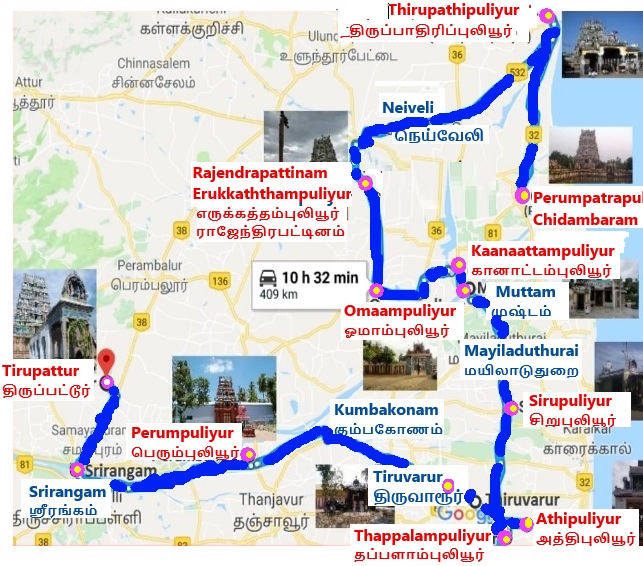

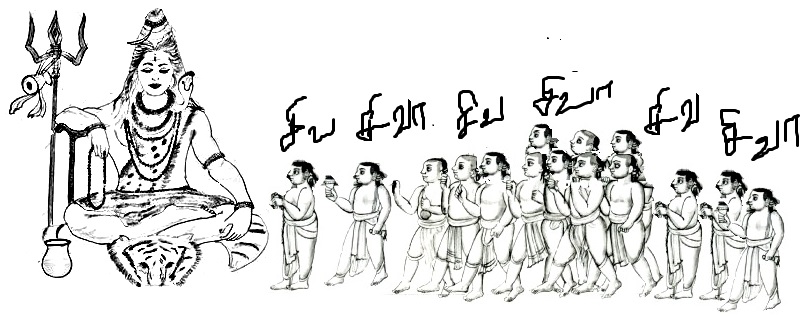
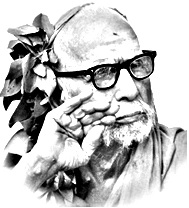

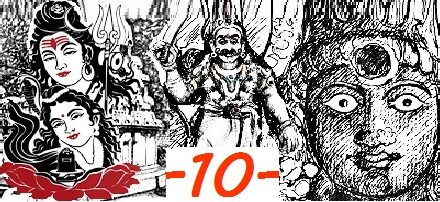
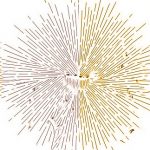
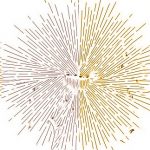

Thanks for the enlightening piece of work- Threw light on various aspects in various angles
Excellent write-up and service sir. Very useful. Pranams.
Good afternoon Sir.
Thanks for this excellent and most detailed writeup about Navapuliyur Yathra.Though I have worshipped in all but Athipuliyur of this nine temples, it was not as prescribed for this yatra.Also details of location of Athipuliyur, which I haven’t worshipped are clearly given here.Even Google maps is wrongly marked.Now with your blog details I have guven correction to Google which they will publish shortly.Praying Lord Vyagrapureeswarar, Lord Chidambareswarar for blessing me with a dharshan of Navapuliyur.,once present pandemic situation is cleared.Thanks a lot for your post Sir.Moreover the Navagraga Lird blessing the devotees at Athipuliyur is Lord Sukhran, as it was nit mentioned in the post.
Well documented article. I have been writing on each of the nine Puliyur temples in my blog.yesveesbi.blogspot.com This article will be useful to me.